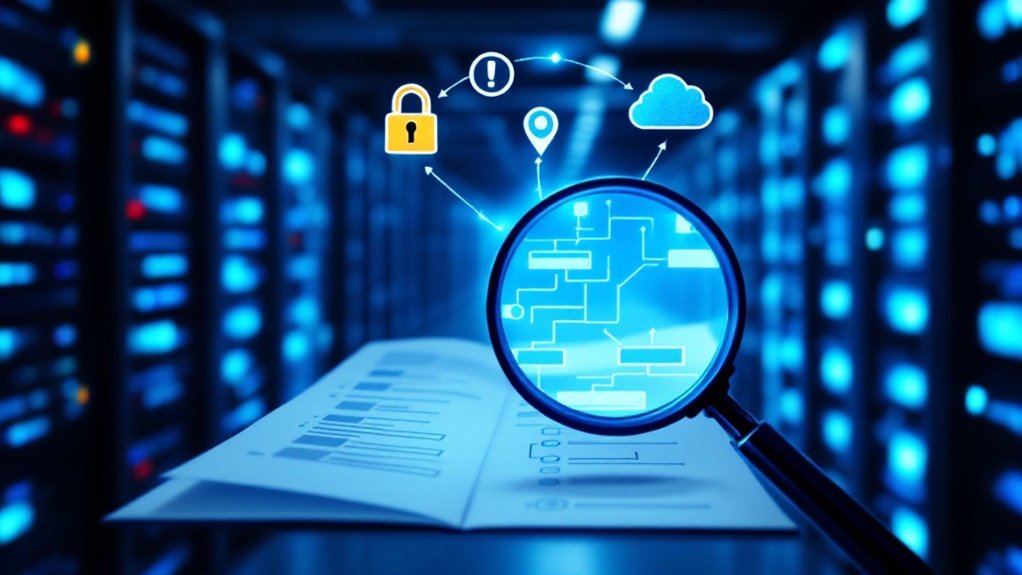In an era of escalating cybersecurity threats, data center security risk assessment has emerged as a paramount concern for organizations. The meticulous process involves identifying critical assets, recognizing potential vulnerabilities, and understanding the profound effects of breaches. But the journey doesn’t end here. Effective risk management, regular audits, staff training, and an inherent understanding of evolving data security trends are equally indispensable. Stay tuned to explore the key steps in ensuring your data center’s security.
Understanding the Importance of Data Center Security
In the digital era, the significance of data center security is undeniable. With the increasing reliance on online services and digital data, businesses now store vast amounts of sensitive information in data centers. These centers are critical to the smooth operation of businesses, and their security directly impacts the organization’s reputation and bottom line. A breach can lead to catastrophic consequences, including data loss, theft, downtime, and significant financial loss. Additionally, it can tarnish a company’s image and erode customer trust. Consequently, conducting regular risk assessments to identify vulnerabilities and enhance security measures is of paramount importance. Essentially, a secure data center is not just an IT concern; it’s a business imperative. Furthermore, data management services are crucial in protecting databases from security breaches and ensuring data integrity.
Identifying the Key Assets in Your Data Center
The next vital step in data center security risk assessment is identifying the key assets within the data center. This process involves not only recognition but also the prioritization of these essential components. A thorough understanding and identification of these assets is instrumental in shaping an effective security strategy. Additionally, participating in data center webinars can provide insights into best practices for asset management and security.
Asset Identification Process
Asset identification serves as an imperative first step in securing your data center. This process involves cataloging each piece of hardware and software, along with relevant data and information assets within the facility. This inventory should be extensive, accounting for all servers, routers, switches, storage devices, and applications, as well as databases and intellectual property. The goal is to have a clear picture of the data center’s assets to help create an effective security plan. Without this knowledge, protecting the center from threats becomes a markedly more challenging task. The asset identification process needs to be thorough, ongoing, and should involve all relevant stakeholders to guarantee no asset is overlooked. This vital step forms the foundation for all subsequent security measures.
Prioritizing Crucial Assets
Why is it essential to prioritize assets within a data center? Understanding the importance of this step lies in recognizing that not all assets possess equal value. Prioritization allows for the identification of key assets, which are those that, if compromised, could greatly impact business operations. This process helps in creating a robust security plan, by focusing on protecting these essential assets first. Examples of key assets might include servers containing sensitive customer data or proprietary business information. By categorizing and prioritizing these assets, organizations can allocate resources more effectively, ensuring the most critical areas are protected. This approach not only enhances overall security but also optimizes resource utilization, making it a fundamental step in any data center security risk assessment.
Recognizing Potential Threats and Vulnerabilities
In the domain of data center security, it is critical to recognize potential threats and understand infrastructure vulnerabilities. Common threats can range from natural disasters to cyber-attacks, each posing unique challenges. Concurrently, infrastructural vulnerabilities may include outdated systems or flawed security policies that can open the door to potential breaches. Implementing security measures is essential to safeguard against these threats and maintain the integrity of the database.
Identifying Common Threats
Though data centers are fortified with the latest security technologies, they are not impervious to threats and vulnerabilities. Common threats that could undermine a data center’s security include both external and internal sources. External threats often encompass cyber-attacks such as malware, ransomware, and phishing attempts. These can infiltrate the system, disrupting operations and potentially causing data loss. Additionally, Denial of Service (DoS) attacks aim to overload the system, rendering it inoperable. Internal threats typically involve personnel, whether through deliberate malicious activity or through accidental mishandling of sensitive data. Moreover, natural disasters like floods or fires pose significant threats, capable of causing extensive physical damage. Recognizing these common threats is a fundamental step in implementing effective data center security strategies.
Understanding Infrastructure Vulnerabilities
While the aforementioned threats pose significant risks, understanding the vulnerabilities of a data center’s infrastructure is equally essential. Infrastructure vulnerabilities may lie in hardware, software, or even the physical environment of the data center. For instance, outdated systems may have unpatched security flaws that can be exploited. Software vulnerabilities could include insufficiently secured databases or unprotected network interfaces. Physical vulnerabilities might encompass inadequate access control, or lack of disaster prevention measures such as fire suppression systems. The key to mitigating these vulnerabilities is thorough risk assessment and proactive management. A detailed understanding of these vulnerabilities allows for the development of robust strategies to prevent breaches, reduce damage, and guarantee data integrity.
Assessing the Impact of Potential Data Breaches
How catastrophic could a potential data breach be for a data center? The impact is indeed significant. A breach can result in the loss of sensitive data, causing financial and reputational damage. In the worst-case scenario, it could lead to the collapse of an organization. The fallout extends beyond the data center to include customers, stakeholders, and even the public sphere. Regulatory fines, legal actions, and loss of trust can follow a breach, further amplifying the damage. It is essential, consequently, for data centers to accurately assess this risk. This involves identifying potential threats, estimating their likelihood, and understanding the magnitude of their potential impact. By doing so, data centers can prioritize their security measures to prevent the most damaging breaches. Implementing real-time monitoring can significantly enhance the ability to detect potential threats before they escalate into breaches.
Implementing Effective Risk Management Strategies
In order to safeguard data centers from potential breaches, effective risk management strategies must be put in place. These strategies begin with identifying potential risks and threats. Once identified, each risk must be thoroughly evaluated for its potential impact on the data center’s operations. Following evaluation, prioritizing risks is vital. Risks with significant potential to disrupt operations or cause substantial damage should be addressed first.
Risk management also involves developing and implementing measures to mitigate these risks. This could include configuring security controls, employing encryption, or developing incident response plans. Continual monitoring is key to guarantee these strategies remain effective and updated. While regular audits are important, they are not the only component of a holistic risk management approach. Additionally, understanding data management processes is crucial for effectively addressing vulnerabilities in a data center’s operations.
Conducting Regular Security Audits
Regular security audits form an essential component of a thorough data center security plan. These audits provide an objective assessment of the existing security measures, identifying potential vulnerabilities and areas for improvement. Proactive in nature, they guarantee that the data center remains compliant with industry standards and regulations.
The audit process involves examining the physical and virtual security controls, reviewing documentation, and conducting interviews with staff. It also includes testing the effectiveness of the security measures in place, such as firewalls, intrusion detection systems, and encryption protocols.
Upon completion, the audit report offers a detailed overview of the current state of security, highlighting areas of concern and providing actionable recommendations. Regular security audits, as a result, play a critical role in maintaining the integrity and confidentiality of data within the center.
Training Staff on Data Security Protocols
While the security infrastructure of a data center is unquestionably critical, equally important is the role that staff members play in maintaining robust data security. Effective training programs are essential in ensuring that each team member understands and adheres to the established data security protocols. Such programs should not only cover the technical aspects of data security but also instill a sense of urgency and responsibility among staff members. Regular updates on latest security threats and responsive measures should be part of the training curriculum. Ultimately, the goal is to foster a security-conscious culture, where employees are vigilant about potential vulnerabilities and proactive in their efforts to protect data. Hence, staff training on data security protocols forms a key step in data center security risk assessment.
Incorporating Data Backup and Recovery Plans
Securing data involves more than just preventing breaches; it also demands a strong focus on data backup and recovery plans. These plans are foundational to any data center security risk assessment, providing a safety net in case of data loss or corruption. The process should begin with identifying critical data assets and determining the frequency and type of backups required. A recovery plan, on the other hand, outlines the steps to restore data swiftly and effectively following a disaster. It is crucial to regularly test and update these plans to guarantee they remain effective. The incorporation of these measures not only mitigates risk but also strengthens an organization’s overall data security posture.
Keeping up With Evolving Data Security Trends
As the digital landscape continues to rapidly evolve, so too must the strategies for data center security. The onslaught of advanced persistent threats, ransomware, and phishing scams necessitates a proactive approach. Cybersecurity professionals must keep abreast of emerging trends, ensuring their strategies evolve alongside the threats. This involves embracing advanced technologies like AI and machine learning to detect and mitigate risks. In addition, the growing prevalence of cloud-based services and remote working requires a shift in perspective. Rather than focusing solely on perimeter defense, organizations must prioritize data protection at all points of potential vulnerability. Ultimately, staying updated with the evolving data security trends is a key step in maintaining robust data center security.
Frequently Asked Questions
What Are the Costs Associated With Data Center Security Upgrades?
The costs associated with data center security upgrades can vary widely. They depend on factors like the size of the facility, the current security measures in place, and the level of security desired.
How Frequently Should Data Recovery Plans Be Updated?
Determining the frequency of updating data recovery plans varies. Factors include changes in business operations, technology advancements, and regulatory requirements. Ideally, it’s recommended to review and update these plans at least once a year.
What Certifications Are Needed for Data Center Security Personnel?
The certifications needed for data center security personnel vary. However, some commonly required certifications include Certified Information Systems Security Professional (CISSP), Certified Ethical Hacker (CEH), and CompTIA Security+. Training and experience are equally important.
How Can Third-Party Vendors Affect My Data Centers Security?
Third-party vendors can impact data center security through their access to sensitive information and systems. If not properly managed, they may introduce vulnerabilities, compromising the overall security of the data center. Consequently, vendor risk management is essential.
What Insurance Options Are Available for Data Breach Incidents?
Various insurance options exist for data breach incidents. These include cyber liability insurance, which covers financial losses, and first-party coverage for immediate business costs related to a breach. The choice depends on a company’s specific needs.
Conclusion
To summarize, the process of data center security risk assessment is imperative in safeguarding sensitive data and operations. It involves the identification of key assets, recognition of threats, assessment of risks, and implementation of robust risk management strategies. Regular audits, staff training, data backup plans, and staying abreast of evolving security trends further strengthen the security framework. This proactive approach helps mitigate potential damages and guarantees the continuity of data center operations.






